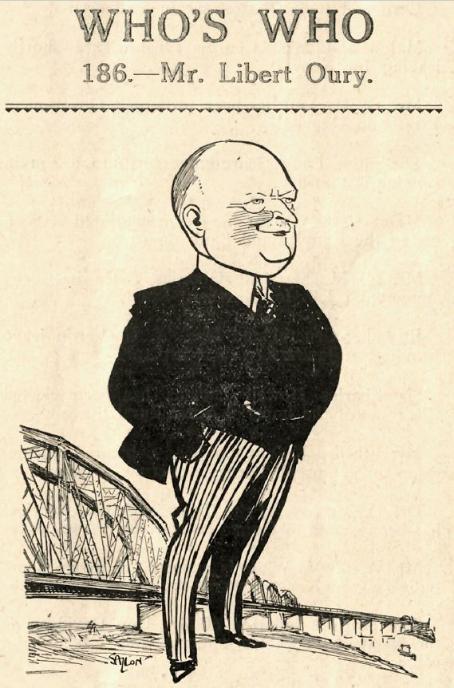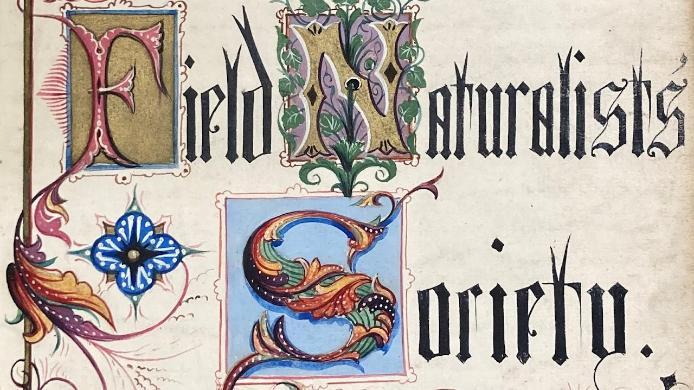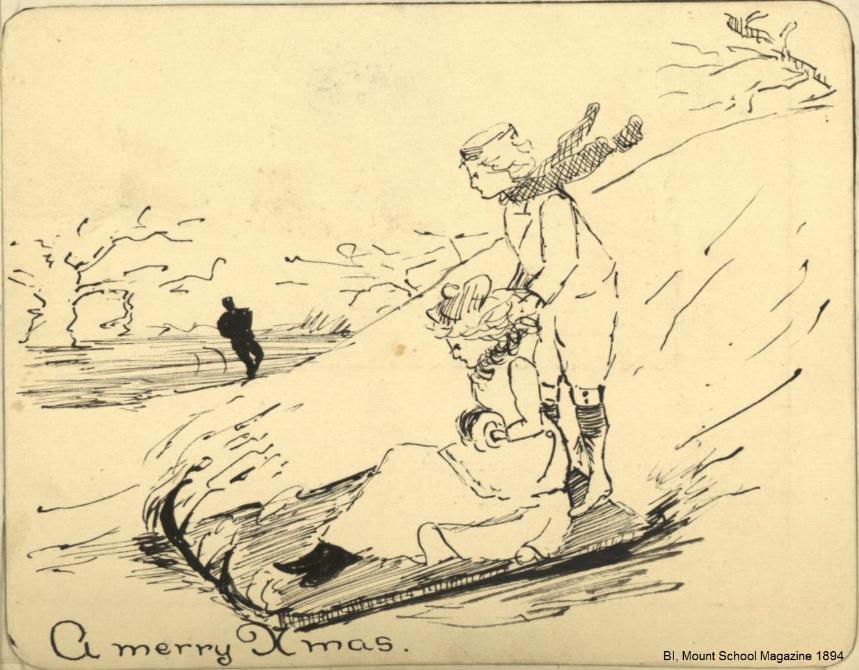Borthwick Newsletter - December 2021
Posted on 30 November 2021
December in the Archives - delve into our catalogues with this month’s featured description
File Relating to the Parliament Scheme, [a Tin of Toffee was Placed on Each Member of Parliament's Seat as They Returned to Parliament, in order to advertise Mackintosh’s Toffee de Luxe product, December 1924]. [John Mackintosh & Sons Ltd Archive, M/S/ELF/57]
What’s New?
We have a bumper newsletter for you this month, with a new website, new catalogues, media appearances and a new blog, as well as news from Rare Books in addition to our usual update from our Conservation team. It’s been a busy end to a year that started in lockdown. If you have emailed, telephoned, written or visited us in the past year, thank you for sticking with us as we have worked from home, and onsite in bubbles, to keep our service running and improve access to our collections wherever we can. Since coming out of lockdown in April our searchroom team have tackled more than 400 enquiries a month, and across the whole Borthwick team we’ve accessioned hundreds of new boxes of records and rare books and added more than 14,000 new archival descriptions to our online catalogue Borthcat. We look forward to building on this work in 2022 and we already have a number of exciting projects in the pipeline, so watch this space!
The most exciting addition to our range of online resources is the brand new Environment and Natural History Collections website, created by Lydia Dean to showcase the significant number of archives here at the Borthwick relating to the environment, landscape and natural history. Chief among these are our organisational and individual archives, from the archive of the Yorkshire Wildlife Trust to the Yorkshire Mammal Group and the Yorkshire Gardens Trust, and from the papers of botanist Kit Rob to those of horticulturist and landscape gardener James Russell. The website also highlights other collections that might, on first glance, suggest few connections to landscape and the environment. However as Lydia shows, our parish and diocesan records, estate and family papers, and rare books might surprise you! The website was featured as part of History Day 2021 by the Institute of Historical Research, which this year had the theme of ‘environmental history’.
New Accessions
We accepted seven accessions in November, all but one of them being additions to existing archives. We added a set of parochial church council records to York’s St Michael le Belfrey parish archive, bringing the archive right up to 2021. We also added some subject files from the university Registrar, records from the Academic Support Office, and honorary degree certificates to the University of York Archive, as well as adding some new records to the Southern African Papers of Christopher Hill. A particularly exciting addition was the minutes and administrative records of Alcoholics Anonymous Great Britain’s General Service Board, which puts the finishing touch to phase one of the Alcoholics Anonymous Great Britain Archive cataloguing project which began in 2018. You can read more about the project in the ‘New Catalogues’ section below.
Our brand new archive is an addition to our increasingly rich collection of writing and performance archives. Recently we shared the acquisition of our Frankie Howerd Archive, well we can now add the papers of British television producer, director and dancer Ernest Maxin, who produced the famous Morecambe and Wise Show from 1974-1977. More on that in future newsletters!
News from Conservation
This month in Conservation I have enjoyed some peaceful time treating a plan from the Rowntree archive. This is my favourite time of year for repair work, when in spite of the chilly climate control it feels quite cosy in the brightly lit workshop as the nights are drawing in.
-567x425.jpeg)
The plan I am repairing has some large tears running around the edges, which have previously been repaired with self adhesive tape. The tape carrier has peeled away and been lost, but it has left staining and adhesive residues behind. After I had documented the plan (you can read more about documentation in our June newsletter), I gave it a light surface clean, and conducted some solubility tests on the various media. Once confident about what solvents I could and couldn’t use, I was able to use solvents both for poultices to remove the adhesive residues and reduce the staining, and also to humidify the item and press it flat.
-567x569.jpeg)
I have been using a toned Tengujo tissue for the repairs so far. By using a light box under the paper and a sheet of polyester over the paper I can use a water-pen to trace out the repair shapes I need from the tissue. I then adhere these to the plan with wheat starch paste, and press the repair dry between a non-stick material, blotters and a weighted board. Once the repairs are dry they can be trimmed. It’s a slow and methodical process, with a number of stages, which (when it goes right!) can be very relaxing. Perfect for an autumn afternoon.
News from Rare Books
Work has continued on the two manuscript inventories that came with the Petyt library. Aidan Collins and Kirsty Wright, funded by a CREMS support grant, completed one volume and made good progress on the second. So far, nearly 1500 books have been identified that are listed in the inventory but are not now physically in the collection which has raised lots of questions. There is evidence that the collection was kept in poor conditions at some point so we may be looking at loss through natural causes. Or could it be deliberate theft or borrowing and forgetting to return? We will probably never know.
The other question is whether the original Petyt collection was even bigger than the nearly 5000 items we have in rare books today. We’re not sure at the moment how much has been added since the original bequest so there’s lots to think about and lots more research to do.
The second batch of Joseph Rowntree reports has arrived and been unpacked and we are expecting the final set imminently bringing the total number to around 7000. They include work from pioneers in social research like Pearl Jephcott who carried out groundbreaking research on life in high rise social housing in the 1960s. We are now working out the best way to catalogue these and make them available for teaching and research.
York Minster Library
The Friends of York Minster recently funded a project to update the catalogue records for the 114 pre 1501 books in the Minster Library. The work has allowed us to build on the Neuton project of 2014 and fill in some of the gaps in our knowledge of the library’s development..
If you would like to find details on ownership, binding and decoration please go to york.ac.uk/library and put ‘York Minster incunabula’ in the catalogue search box.
New Catalogues
Number of archival descriptions on Borthcat on 1st December 2021: 86,663
With generous funding from the Archives Portal Europe Foundation, the Borthwick has been able to put online a new finding aid and create authority records for the Oury Archive. Deposited through the University’s former Centre for Southern African Studies, the Oury Archive holds material primarily related to the business ventures of Libert Oury, a railway tycoon who drove infrastructure projects in colonial African territories held by the British and Portuguese Empires in the early 20th century. A director of the chartered Mozambique Company, Oury instigated and oversaw the development of the Port of Beira in Mozambique, the Lower Zambezi Bridge, and the Trans-Zambezi Railway. A shrewd negotiator, Oury played British and Portuguese governments against each other to raise funds for his projects, and guaranteed financial assurances which were rarely met.

Upon his death in 1939, Libert’s directorships and business interests passed to his son Vivian, who managed them until the 1970s. The archive spans 60 boxes, and includes company reports, visiting directors’ and management reports, contracts, agreements, minutes, and official and general correspondence related to the Mozambique Company and the various railway companies operating in southern Africa that Libert and Vivian oversaw. It is a rich source of information about Libert Oury and the Mozambique Company and for railway studies, and documents European colonial policy and commercial imperialism during the twilight of both the British and Portuguese empires.
December also marks the end of the first phase of the Alcoholics Anonymous Great Britain Archive cataloguing project. Founded in Akron, Ohio in 1935 by two alcoholics, stockbroker Bill Wilson and medical doctor Bob Smith, the first AA meeting in Great Britain took place in 1946, and by 1957 it had become a registered charity with hundreds of groups across the country. Now headquartered in York, AA GB has been depositing archive material with the Borthwick since 2009, and 2018 was the beginning of a major three year project to catalogue, repackage, and promote the archive. It comprises over 300 boxes, and contains material created across the many facets of AA GB’s service structure. This includes a wide variety of material created by its 120 intergroups and 15 regions, trustee and committee minutes, documentation from national and international conferences, AA literature and newsletters, and audio-visual recordings.
The catalogue will play an important function in helping AA GB preserve its heritage, and make it accessible to its members as well as researchers. The archive documents AA’s 75 year history in Great Britain, and provides valuable insight into the development of medical and psychological treatments for alcohol abuse, and reveals how British attitudes toward alcohol and alcoholism have changed over the course of almost a century. In 2022, the archive will play a vital part in AA GB’s 75th Anniversary events, including in the production of a film and history website.
Borthwick in the Media
We started the month with an appearance on BBC Radio York! Keeper of Archives Gary Brannan joined reporter Julia Lewis to discuss our new Frankie Howerd Archive. If you missed the announcement of the archive in October, you can find out more about it on our dedicated Frankie Howerd website.
On the 4th November the Borthwick took part in two online events - History Day 2021 and the annual Ask A Conservator Day. Conservator Catherine Firth answered some of your conservation questions, including how to store old newspapers, what her favourite tool was and why, and the best method for saving photos from albums with sticky plastic glue.
November also brought an update on the Borthwick's Digital Preservation activities over at the Digital Preservation Coalition blog, providing a glimpse into early efforts to appraise and preserve the varied video content sprinkled throughout the Institute's collections. Digital Preservation Archivist Mark Simon Haydn describes the work of ironing out kinks in the digitisation workflow, with a particular focus on making use of community tools supplied by hobbyists, experts and other institutions, previewing some of the Borthwick collections targeted for digitisation.
Finally, as the festive season is fast approaching, we wanted to remind you that we have a special Christmas edition of our Borthwick podcast available online. The podcast features festive highlights from across our collections, read by members of Borthwick staff to give you a taste of how Christmas was celebrated (and not celebrated) over the centuries. From the raucous antics of Yule and Yule’s wife in 16th century York, to Joseph Rowntree banning Yule Candles, and favourite 18th century recipes, there’s plenty to enjoy!
Archive of the Month: Records of York and District Field Naturalists’ Society
What is it? The records of a society founded in March 1874 to further scientific research in York, with the stated object of enabling its members to thoroughly study the various branches of natural history. As well as monthly meetings, at which members were encouraged to bring specimens for show, the Society enjoyed regular lectures and summer field excursions. In 1884 the Society amalgamated with St Thomas’ Field Naturalists Scientific Society and later it became part of the Yorkshire Philosophical Society.
Where can I find it? The full catalogue for the archive of the York and District Field Naturalists’ Society is available on Borthcat
Why is it Archive of the Month? With the launch of our new Environmental Collections website, it seems an excellent time to highlight this rich archive concerning the study of natural history in York. Beginning in 1874 with the foundation of the Society, the archive includes an almost complete run of minute books for the YDFNS, and the only surviving minute book of the St Thomas’s Field Naturalists Society. As well as recording the business of the Society, the volumes include information about rules and members, lectures and excursions, press cuttings, and even the occasional letter - including an intriguing one from 1904 written by member William Hewett who refuses to apologise to the Reverend Mackay for an insult given!

But the Society wanted its members to carry out new research, as well as to discuss it, and the archive includes a wealth of biological recordings collected by members between 1894 and 1997 on all kinds of subjects, including insects, birds, butterflies and moths, shells, plants, fish and mammals. There is, naturally, a particular focus on Yorkshire flora and fauna. Highlights include notes on sturgeon at Naburn Locks in 1897, on hare breeding, and a guide to the birds of Wheldrake Ings c 1980. The Society also carried out field studies of particular areas, including Rawcliffe Ings, Clifton Ings and the Moor Plantation on Wigginton Road. Beginning at a time when such study was often dependent on local interest, the records of the YDFNS chart the achievements of a group of enthusiastic amateurs who applied scientific methods to the study of the natural history of their region, and who recorded their findings for posterity.
*********
Have a wonderful December and we’ll be back in 2022!


